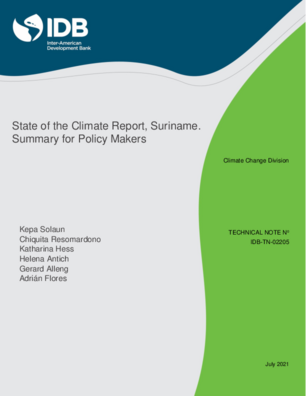State of the Climate Report: Suriname: Summary for Policy Makers
Date
Jul 2021
Several factors contribute to Surinames particular vulnerability to the effects of climate change. It is dependent on fossil fuels, has forests liable to decay, fragile ecosystems, and its low-lying coastal area accounts for 87% of the population and most of the countrys economic activity. Many sectors are at risk of suffering losses and damage caused by gradual changes and extreme events related to climate change. For Suriname to develop sustainably, it should incorporate climate change and its effects into its decision-making process based on scientific- evidence. The State of the Climate Report analyzes Surinames historical climate (1990-2014) and provides climate projections for three time horizons (2020-2044, 2045-2069, 2070-2094) through two emissions scenarios (intermediate/ SSP2-4.5 and severe/ SSP5-8.5). The analysis focuses on changes in sea level, temperature, precipitation, relative humidity, and winds for the seven subnational locations of Paramaribo, Albina, Bigi Pan MUMA, Brokopondo, Kwamalasamutu, Tafelberg Natural Reserve, and Upper Tapanahony. The Report also analyzes climate risk for the countrys ten districts by examining the factors which increase their exposure and vulnerability on the four most important sectors affected by climate change: infrastructure, agriculture, water, and forestry, as well as examining the effects across the sectors. The State of the Climate provides essential inputs for Suriname to develop and update its climate change policies and targets. These policies and targets should serve as enablers for an adequate mainstreaming of climate change adaptation and resilience enhancement into day-to-day government operations.




